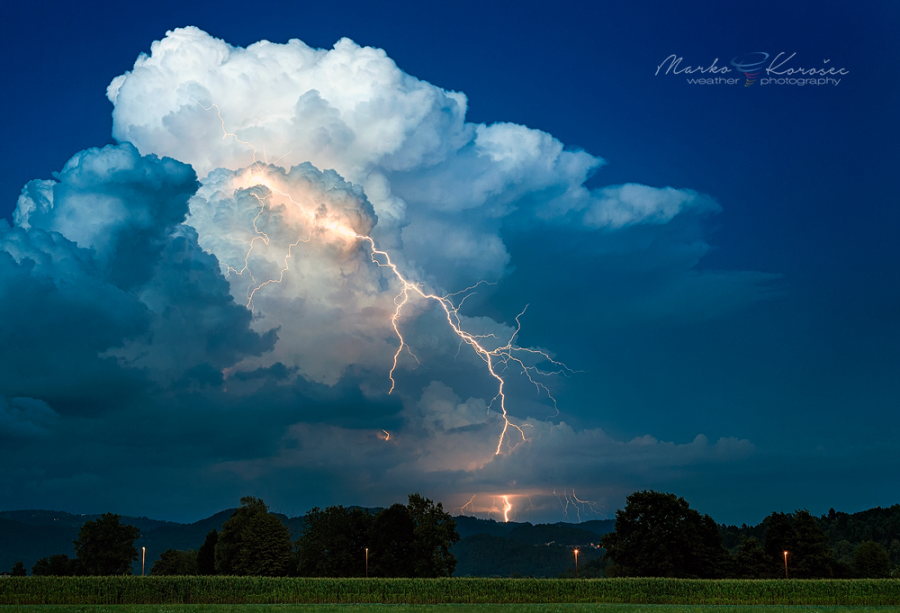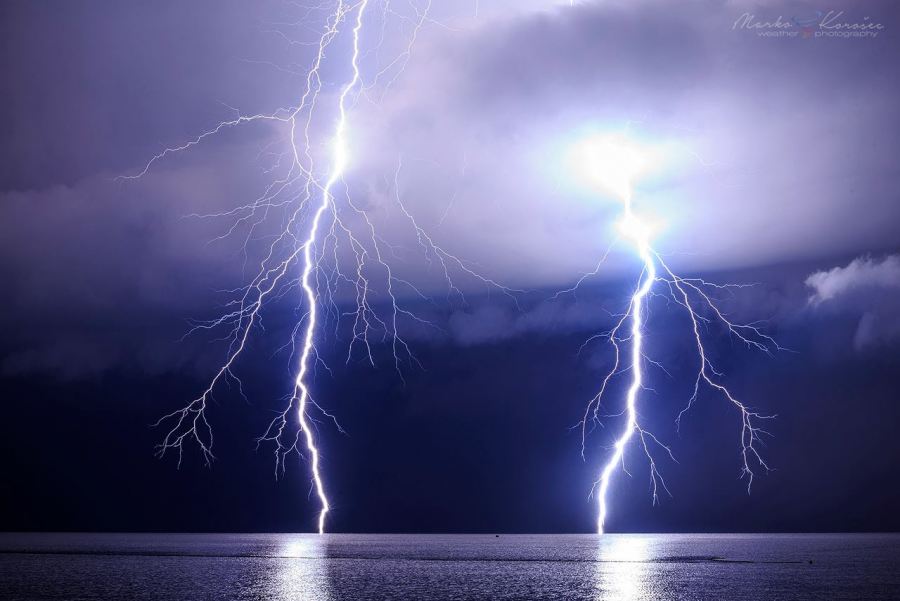Interested in lightning? Here are Top 10 most interesting and surprising facts about this awesome phenomenon:
1. Can lightning strikeout of a blue sky? Yes, almost.
Some lightning bolts can appear to hit from a clear blue sky. A “Bolt from the Blue” is a cloud-to-ground lightning bolt, which comes from the side of the thunderstorm cloud and travels through clear air away from the storm, eventually striking the ground. They can strike tens of kilometers from the thunderstorm, under the clear, blue sky, hence the name.
Bolt from the blue from the updraft tower on a storm in central Slovenia on July 21, 2016. Photo: Marko Korošec.
While most bolts from the blue hit within several tens of kilometers of the thunderstorms, they can reach much further out. A bolt from the blue struck 74 km (46 miles) ahead of an advancing squall line near Ponca City, Oklahoma on June 25, 2018.
Not feeling very safe? How about this? The longest detected lightning bolt happened on June 20, 2007 in Oklahoma. Remote lightning sensors detected a bolt which covered a horizontal distance of 321 km (199.5 miles). The bolt propagated from the main storm updraft along the stratiform anvil region of the storm (anvil crawler). Along the way, the lightning bolt produced 13 cloud-to-ground strikes. While technically not a bolt from the blue, the distance from the main thunderstorm updraft makes this a record-setting event.
2. The most time a single person was hit by lightning – 7 times!
United States park ranger Roy Cleveland Sullivan was hit by lightning 7 times. He was first struck in 1942 at age 30 and the last time in 1977 at age 65. He survived all 7 strikes, earning him the nicknames “Human Lightning Conductor” and “Human Lightning Rod”.
All seven strikes were documented by the superintendent of Shenandoah National Park, R. Taylor Hoskins. He was not, however, present during any of the seven reported events.
It is extremely unlikely that Mr. Sullivan was actually hit directly 7 times, rather at least some of the hits were indirect.
3. The place with the most lightning in the world is Lake Maracaibo, Venezuela
The place with the most lightning in the world is in above the Catatumbo river, feeding into Lake Maracaibo, Venezuela. Up to nearly 150-300 lightning days per year, 30 lightning flashes per minute and 233 lightning flashes per square kilometer per year.
Comparison of lightning flash rate for Lake Maracaibo and Lake Victoria, the previous record holder for the highest lightning rate in the world. Units are in lightning flashes per square kilometer per year. Map: University of São Paulo.
Learn more:
Catatumbo lightning: The place with the highest lightning activity in the world
4. Central Florida, USA gets so much lightning it is dubbed “Lightning Alley”
The area from Tampa to Orlando and Tampa to Titusville, Florida gets so much lightning activity, it has been dubbed “Lightning Alley”. By various sources, the area receives anything between approximately 10 and 35 lightning flashes per square kilometer per year.
5. The place with the most lightning in Europe is northeastern Italy
Europe gets its fair share of lightning, particularly during the summer months. But the place with the most lightning is the Friuli region in northeastern Italy – with over 50 days with lightning per year. And, according to analyses, thunderstorm frequency in this area is increasing.
Big lightning barrage over the north Adriatic on September 24, 2017. Photo: Marko Korošec.
On to the next 5 interesting and surprising lightning facts
6. In 1769 lightning struck the Church of St. Nazaire in Brescia, North Italy igniting 90 tonnes of gunpowder.
This event, also known as the Brescia explosion happened on August 1769. A lightning bolt struck the Bastion of San Nazaro where the Republic of Venice stored no less than 90 000 kg of gunpowder. The massive explosion hurled large stones up to a kilometer from the site, hitting buildings and people. City gates were blown open as were doors of houses and shops. Reports indicate about a sixth of the city was destroyed and possibly up to 3000 people died in the blast, although an official account reports 400 fatalities and 800 injuries.
Result: the Roman Catholic Church renounced their objection to protect property using lightning rods.
7. There are lightning superbolts
Lightning super bolts are loosely defined as 100 times more intense than average lightning. About 1 in 1000 lightning bolts exceeds an (optical) power of 100 GW and about 5 flashes in a hundred million exceed an optical power of 3000 GW.
In fact, lightning super bolts are so bright and powerful, they were first detected by the Vela satellites in the 1970s. Vela satellites’ main purpose was to watch the entire globe for nuclear explosions. Lightning super bolts were bright enough to register on satellite sensors designed to detect nuclear blasts.
A super bolt on May 31, 2012, in Tulsa, Oklahoma rattled the town with earthquake-like shaking. Car alarms were set off almost a kilometer from the strike and picture frames fell off the walls! A super bolt in Illinois is reported to have broken windows, shook houses and produced a 2-m wide and 30-cm deep crater at the strike point.
Big CG lightning bolt off Rovinj, NW Croatia on September 19, 2017. Photo: Marko Korošec.
8. The electric field from an approaching thunderstorm can make your hair stand on end
Hair standing on end is a bone-chilling precursor to a nearby lightning strike. Remember those experiments in school, where you rubbed a plastic rod against a cloth, held it to close to your head and your hair stood on end? When you rub the balloon against your sweater, charge separation occurs: electrons are transferred to the balloon. Both the sweater and the balloon acquire static charge, the balloon positive, and your sweater negative. When you move the balloon to your hair, the negative charge on the balloon induces a positive charge on your hair, making it stand on end.
A similar process happens in thunderstorms. Lightning flashes are discharges of static electricity within a very powerful electric field, generated by the thunderstorm. Charge separation occurs within a thunderstorm, generally producing a negative charge in the lower part of the cloud and positive charge in the upper part of the storm, producing a powerful electric field. A charge is also induced on the ground, producing a powerful electric field between the cloud and the ground. When the electric field becomes powerful enough – reaching breakdown voltage – a lightning flash happens.
Hair standing due to the intense electric field. You are in the danger zone if this happens to you.
Your hair standing on end is a clear sign of the presence of a powerful electric field; the more your hair strands, the stronger the field. Strong enough for lightning to strike somewhere close. There have been recorded instances of people with hair standing on end being photographed, just before a lightning strike. If your hair is standing on end during a thunderstorm, you are in the danger zone!
9. The longest continual lightning flash
You have probably seen some lightning bolts that last longer than usual, perhaps a second or two. Think that was long? The longest reported duration of a continual lightning flash was nearly 8 seconds! A lightning flash in Provence-Alpes-Côte d’Azur in southern France in 2012 was measured to last 7.74 seconds. Take a stopwatch and measure that – imagine a lightning bolt persist for so long! In comparison, the average duration of a lightning flash is 0.2 seconds.
10. Better odds than the lottery
Your odds of being hit by lightning are actually better than your odds of winning the lottery. Of course, your odds depend a lot on your location; you are fairly safe from lightning if you live in the arctic circle. In places with more lightning, it is a different matter. In the U.S., the National Weather Service estimates the odds of being struck by lightning in your lifetime is approximately 1 / 15 300. About 10% of lightning strikes result in death, but as much as 70% leave permanent effects.
More about lightning:




